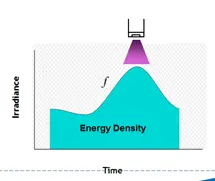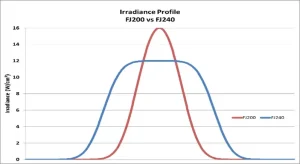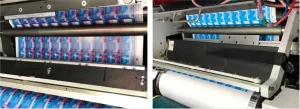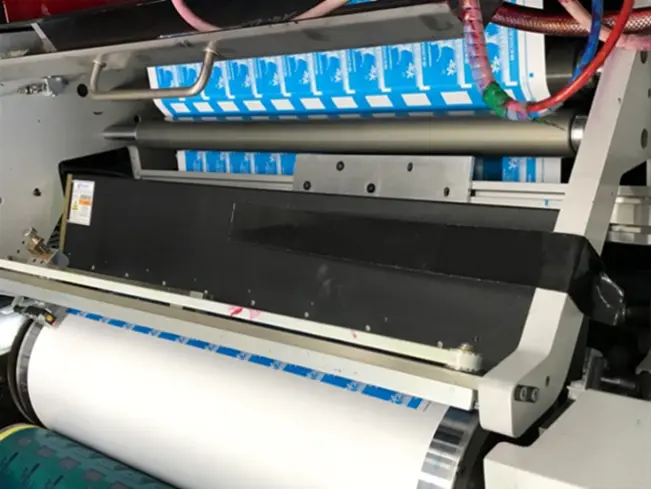By Mike Higgins, director of sales – Americas, Phoseon Technology
Now that UV LED has been established as a viable alternative to traditional curing methods, more converters are researching ways to benefit from this emerging technology. A quick Google search will reveal a ton of information regarding peak irradiance of curing systems.
In flexographic printing, peak irradiance is an important factor in achieving consistent cure on all jobs. Common challenges for converters upgrading to LED include insufficiently cured ink and yellowing of overprint varnish. What often gets overlooked is a consideration of the energy density (or dose) generated by the LED curing system. In most cases, increasing energy density will solve these common challenges.
Two important power measurements should be considered when evaluating LED:
Irradiance (W/cm2) is the punching power to kick-start the polymerization process where photoinitiators cross-link acrylate monomers and oligomers in UV-curable adhesives, coatings and inks. A minimum threshold irradiance value is required to start this process; anything greater than the minimum threshold will convert to heat. It is not a given that higher irradiance will enable faster cure speeds.

Energy density (J/cm2), commonly referred to as dose, is the time integral of irradiance that can be calculated by multiplying irradiance (W/cm2) by time, as depicted in Figure A. It is the total number of light photons that hit a specific area within a duration of time. Energy density is the key to ensuring adhesion and cross-linking at high speeds.
External Factors That Affect Energy Density
Two external factors impact energy density, and converters should be aware of the effects.

Dwell Time is the duration of time the ink, coating or adhesive is exposed to UV energy. Dwell time is impacted by line speed and size of the LED array. Line speed of 50 m/min (164 feet) exposed to a 20 mm (0.78 inch)-wide UV LED curing lamp will have the same dwell time as material running at 100 m/min (328 feet) exposed to a 40 mm (1.57 inch)-wide UV LED curing lamp.
- In Figure B, the red line represents an LED lamp with 16W/cm2 peak irradiance and 20 mm-wide array vs. the blue line, which represents an LED lamp with 12W/cm2 and 40 mm-wide array.
- Energy density of the blue line is 65% greater than the red line despite 25% lower peak irradiance.
Total Number of LED Lamps: Adding more rows or banks of LED curing lamps will increase the overall energy density exposure of the substrate. LED lamps are compact, and adding rows is a way to increase energy density.
Factors to Consider for Maximum Energy Density
Not all LED curing lamps with the same peak irradiance have the same total curing power. Certain high LED concentration arrays have measured significantly greater energy density compared to others that have the same peak irradiance on the label. LED lamps with insufficient energy density often use focusing optics to boost peak irradiance.

In a flexographic application, the presence of tracking (the term used for insufficiently cured ink transferred from web to idle rollers) clearly was shown using a curing system with 17W/cm2 of peak irradiance, as shown in Image 1 on the left. On the right is the same line with a 16W/cm2 LED lamp, and no tracking is present. Energy density was measured to be 40% higher on the right vs. the lamp on the left, despite lower peak irradiance.
There are many factors within LED lamps that ensure maximum energy density.
Number of Diodes: Total number of diodes has a direct impact on energy density. This author’s company sources diodes that allow tight packing into small spaces. Packing density and total number of diodes per square area allow for more photons delivered, resulting in higher energy density.
Efficiency of Diodes: The diode manufacturing process is such that a certain percentage of diodes from each batch are going to be the most efficient. When these diodes are identified and used to build LED curing lamps, the electrical conversion rate is greater than 50%. These diodes can be pushed to maximum output and provide thousands of hours of consistent output.
Packaging Method of Diodes: Certain wafers arrange native diodes to maximize light output, uniformity and allow for consistent heat management. This leads to a long lifetime.
Heat Management of Diodes: Whether air-cooled or water-cooled, the effectiveness of heat sink will impact power output and lifetime. If kept at a safe operating temperature, both air-cooled and water-cooled systems will last for many thousands of hours.
Conclusion
Finding the ideal combination of irradiance, dwell time and energy density will vary based on substrate, ink/coating/adhesive, environmental conditions and line speed. Working closely with a UV chemistry supplier as well as the LED lamp supplier will result in a well-matched total solution. In all cases, using UV LED lamps with higher energy density will enable faster, more efficient and repeatable cure at higher speeds.
Mike Higgins is the director of sales, Americas for Phoseon Technology and is responsible for a team of direct field sales, agents and distributors in North and South America. Over the last eight years Higgins has contributed to record growth rates by building relationships with industry-leading companies that recognize the value of UV LED. Previous responsibilities include sales and management positions with Sartomer Company, raw material supplier to the UV/EB industry. This combined experience gives Higgins a unique perspective on the UV/EB curing market landscape. For more information, visit www.phoseon.com.







